Silicone/Urethane Casting

What is Silicone/Urethane Casting?
Silicone and urethane casting are commonly used to create LSR (liquid silicone rubber) and polyurethane parts with exceptional precision, consistency, and speed, making these manufacturing processes ideal for low to medium volume production runs (from 1 to the 100s). Parts can be made with flexible or rigid plastic materials. Both silicone and urethane casting require the creation of a mold of the original pattern before the casting material can be poured.
How Does Silicone/Urethane Casting Work?
Silicone and urethane casting use a mold made from silicone rubber. The process involves several steps, including preparing the original, making a mold box, mixing and pouring silicone rubber or urethane into the mold box, waiting for it to cure, and de-molding the final part.
To begin, the original pattern is cleaned and prepared for the molding process. A mold box is created around the original, usually made from wood or cardboard. Silicone rubber is mixed with a hardener, poured into the mold box, and cured for several hours or overnight. Once cured, the silicone mold is carefully removed from the mold box, and the original object is removed. Finally, the mold can be used to create parts in various materials, including liquid plastics and resins.
Silicone casting involves pouring a liquid silicone rubber material into a mold to create a highly detailed and flexible copy of the original pattern. This method is often utilized in the production of medical devices, prosthetics, or toys.
Urethane casting utilizes a liquid resin material that hardens during the curing process, resulting in a durable and rigid copy of the original pattern. This method can be applied to various applications, including automotive and aerospace components, medical enclosures, and consumer products.



Advantages of Silicone/Urethane Casting
Silicone/Urethane Casting offers many advantages, some of which include:
Producing high-quality, precise, and consistent parts
Avoiding expensive tooling
Speed - parts in less than two weeks
Design flexibility similar to injection molding
Wide range of plastic materials
Silicone/Urethane Casting Materials
The main Silicone/Urethane Casting materials are:
LSR - Liquid Silicone Rubber
Urethane - A wide range of polyurethane resins are suited to this process

Silicone/Urethane Casting Applications
Silicone/Urethane Casting is used in a number of industries and products. Some examples include:
Aerospace: Airframe and aircraft interiors, satellite components, turbine housings, turbine blades, radomes, battery housings, circuit boxes, flame resistant housings, pilot and navigation controls, missile precision optical components
Consumer: electronic housings, appliances, toys, sporting goods
Energy: Sensor devices, metering equipment, smart grid components, fluid handling equipment
Industrial: Food processing equipment, irrigation systems, agricultural equipment, mechanical parts, fluid handling systems, urban/organic farming
Medical: Medical cart skins, diagnostic components, drug delivery devices, respiratory equipment, surgical robotics, imaging systems, dental equipment, biotech instruments, patient treatment chairs
Technology: Telecom adapters, router housings, cable connectors, electronic housings, computer parts
Transportation: Automotive parts, RV components, ATV controls and parts, train seats, watercraft parts, snowmobile accessories, fluid handling systems
.png)










